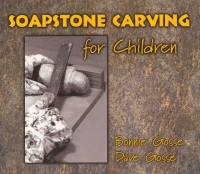| ________________
CM . . .
. Volume XI Number 15 . . . .April 1, 2005
Soapstone Carving is a step-by-step discussion for pre-teens as to how to approach soapstone carving. Young readers are guided through the entire process of carving through the various stages of carving, such as: understanding composition and balance; seeing the object to be created within the stone; and understanding tools. As well, the book addresses basic and refined techniques to the actual carving of soapstone. Each stage is carefully laid out and is made easily understood with drawings and photographs. The photographs are obvious aids when showing the development of these sculptures, but they are also essential in demonstrating proper safety techniques. The charm of this book is that the reader is introduced to three children whose soapstone sculpture creations illustrate the techniques being discussed. Throughout the book, the discussion is kept personal by mentioning the children and their projects. Young readers can both identify with what their counterparts are doing in the book and feel that the projects are achievable as the writers speak directly to young readers in the text. A poem at the beginning of the book would also be of interest to parents and children alike as is the brief discussion of soapstone's history in both the front and back of the book. While safety issues are discussed and emphasized in this book, it still might be wise if an adult does the carving of the soapstone rather than a pre-teen. Issues around stone dust and using an oven also raised in the book. Young people following the book's instructions should be supervised by an adult who should be aware of what will be required of the young reader in these projects. The book, while an introduction to soapstone carving, is also a useful initiation for children in seeing beyond external surfaces, to think in three dimensions, and to be observant while patiently working toward a pleasurable goal. The authors write:
Projects like soapstone carving demonstrate how to plan, how to correct for errors and how to use both hands and the mind in concert to create something truly personal and original. Gently anticipating the problems their young readers might experience, the instructions in the book tell readers ahead of time what could go wrong with an approach and how to correct for it:
A young reader's experiencing the tactile nature of carving is an important activity in a world in which computers increasingly make the creative cognitive leaps for young minds. Highly Recommended. J. Lynn Fraser has written two guided reading books for grade six readers, and her articles appear in international magazines and newspapers.
To comment
on this title or this review, send mail to cm@umanitoba.ca.
Copyright © the Manitoba Library Association. Reproduction for personal
use is permitted only if this copyright notice is maintained. Any
other reproduction is prohibited without permission.
NEXT REVIEW |
TABLE OF CONTENTS FOR THIS ISSUE
- April 1, 2005.
AUTHORS |
TITLES |
MEDIA REVIEWS |
PROFILES |
BACK ISSUES |
SEARCH |
CMARCHIVE |
HOME |
